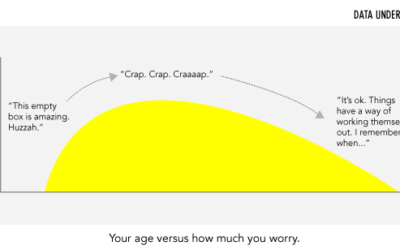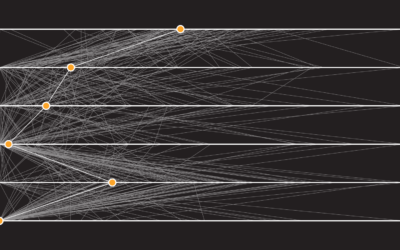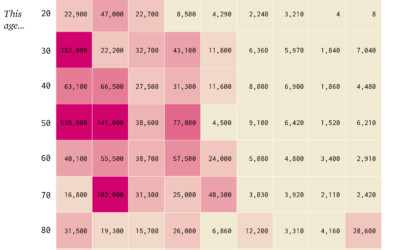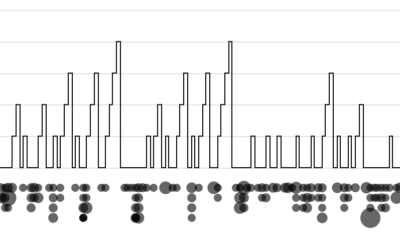How long does it take to burn off the calories from a Big Mac and medium fries or a chocolate chip cookie? Petra Axlund of 5W Infographics shows with this infographic how long you have to exercise, after eating a certain item, to burn it all off.
The red outside track shows the number of calories from the food item, while the inside tracks represent how long it takes for a male or female to burn off those calories with different exercises.
Percentage Problem
While creative, and as they say, visually appealing, it doesn’t quite work technically speaking. The primary purpose of this graphic is to compare how long it takes to burn off the calories of a food item with different exercises. However, arc lengths are formed by percentage of an undefined whole, as opposed to count (in this case, calories on the outside and minutes out the outside).
Okay, that last paragraph probably made no sense. Let’s look at an example. This issue is most evident in pizza section. According to the graphic, it takes the average male 352 minutes to burn off a pepperoni pizza while it takes just 234 minutes to run it off. Therefore, the running arc for male should be about 2/3 the size of the walking arc if it were a bar chart.
Instead we’re comparing percentages, and the running arc sorta looks like it’s about 3/4 the size of the walking arc. It’d probably look different if you were to roll out the arcs into bars, but that’s too much brain power for me. I’m lazy like that.
How it Could’ve Worked
I think there’s another way to make this graphic work other than making a bunch of bar charts. Instead of graphing minutes to burn off x amount of calories, show number of calories burned after x hours of exercise. It’d still be a little weird and less colorful, but it’d be more informative and easier to compare. It’s mostly eye candy and a one-way reference as it is now.
Gosh, I hate to be so critical, but it just doesn’t work for me. What do you think?
[via metrobest]






Yes, circular layouts seem to be all the rage. And this one is really nice to look at! Too bad s = r * theta (arc length is really short near the center…) I can’t tell if that 713 vs. that 460 is illustrated linearly or angular-ly.
The creator seems to have re-discovered old-style telephones–look at the center of the chart where the “calorie intake” and “calorie outtake” arrows are shown–diiiiiaaaaal-click-click-click-click. Dial a beer, click off 27 minutes of walking. This is an interesting concept and it is nice to see experimentation.
But it seems to me the info here could be shown in two simpler charts: relative calories for various food types, and relative burn-rates for various excercises.
By combining a set of “n” numbers and a set of “m” numbers, she ended up having to show “n x m” quantities, so to speak, for not much gain.
Yes, it’s nice to know how long I need to run to burn off a beer or a pizza, but if I know that a pizza is ten times more than a beer, well…
The cave man graphic would clearly illustrate “Pizza make fat” and “Run make skinny.”
Wheels are meant to be held and spun around in hand, therefore the author should not have flipped the text for Tuna and BigMac. Even more abrasive is the fact that Yoga was flipped for pizza.
If all activities are in minutes – one unit should have been shared – which could have saved some space and allowed for a larger (less strenuous) typeface.
I agree, showing clearly how long it takes to burn off calories is useful information. I do like the idea of throwing certain popular foods into the mix though, as it gives a feel for day to day reality.
Also, it needs to give a real flavour of the figures more quickly; at the minute you have to work out the architecture of the chart before you can glean any of it’s insights.
As such I couldn’t resist a quick reworking: http://playpretty.info/calories
regards,
ritchie
Good observation. Another way of making this work would be to the slowest way of burning calories (here: yoga) and treat as 100%, filling up the whole arc.
So if a pepperoni pizza is 1,727 calories, then 713 minutes of yoga for women would be 100% and other times would be pictured relative to this. That’s basically treating minutes of women’s yoga as a constant measure of translation to and from calories.
Also, another thing to make this chart better would be to use angles, not lengths, for presenting the exercise arcs. Running being closer to the center of the circle than walking, its arc looks longer than it in fact should be, as you point out.
@ StaÅ›. That’s how bad this graphic is. At first glance, it makes you think that those foods and drinks add up to 2647 calories; but they don’t – they are individual: looking at the first two drinks give us a ‘clue’. A beer is not 25 calories. I also double checked the big mac and fries elsewhere to make sure! 920 calories is about right.
Ok, folks, the critique phase seems complete. Let’s see alternatives-
from a technical standpoint, ritchielee’s rework is pretty good
On one hand I don’t like it as it took me a long time to work out, and even then I found it tough to use.
On the other hand I do like it for the sake of experimentation.
Overall I don’t think it meets it’s objective, simply because of the subject rather than the presentation.
Exercise intensity is at least as important as duration, so it has to be included in any attempt like this. The calories burned also varies so much between people of different size, shapes, fitness levels and body composition. You’d have to include those as well. Exactly what sort of pepperoni pizza is it? On dominos website I can create a pepperoni pizza with 1536 calories and another one with 3440! I think any attempt should also include exact product name and exact serving size.
So with all that uncertainty, I doubt a graphic will do the job. It needs more of a calculator that takes into account all the parameters.
@nathan, @ritchielee
On that chart, the big mac and fries requires about 2.5 hours walking and about 1.6 hours running. Walking is roughly 1.5 x running.
However using Metabolic Equivalents (METS) for a relative comparison, “walking” at various speeds is 2 to 8 METS while “running” at various speeds is 8 to 18 METS.
So I can much bigger or smaller than x1.5 …. then it matters what I weigh etc etc.
Different graph, same problem.
Pingback: Chart Busters Calorie Chart | PTS Blog
I think the general problem of clarity is the main issue – an infographic should let me see an instant picture and derive some of my own findings e.g. how much running do I have to do to burn off 3000 calories?
The technicalities of exactness can never work here, so we have to go for a general view somehow. someone running at 12mph for 30 minutes is going to burn more calories than at 8mph right?
right.
which is my point.
the charts are going to tell you incorrect answers unless they take into account the right parameters, which I think are too hard for such charts.
so an infographic is not going to tell you the answer to the question.
it’s the wrong tool.
I’ve reworked this chart on my blog, as part of the Chart Busters series:
Chart Busters Calorie Chart
Here’s a list of different exercises based on your weight that will burn 300 calories.
A three-scale nomogram for this graphic provides a very readable and usable format — see http://www.myreckonings.com/Pynomo/CaloriesIntakeAndOuttake.pdf . To use a nomogram you place a straightedge across values on any two of the scales to intersect the corresponding value on the third scale. The scales also make it easy to mix exercise types and times. Consider working off a 920 Calorie Big Mac and Fries. If a man were to run for 50 minutes, the nomogram shows 565 Calories were expended; then he could continue walking 47 minutes to work off the extra 355 Calories. (This nomogram was created with the Pynomo software at http://www.pynomo.org)
Visio Guy: [But it seems to me the info here could be shown in two simpler charts: relative calories for various food types, and relative burn-rates for various excercises.]
My thoughts: I agree. If you put them back to back, then you get this: http://cid-f380a394764ef31f.skydrive.live.com/browse.aspx/.Public?uc=1
All I’ve done is unwind the original graph. I ran out of the inclination to show male vs female, but this would be easy enough to work in. I originally posted this (and most of the below comments) in the comments of Jon Peltier’s blog at
http://peltiertech.com/WordPress/chart-busters-calorie-chart/#comment-15715#ixzz0JtzVEKXZ&D
VisioGuy: [The cave man graphic would clearly illustrate “Pizza make fat†and “Run make skinny.â€]
Ritchielee: [I do like the idea of throwing certain popular foods into the mix though, as it gives a feel for day to day reality.]
My thoughts: I think the bad things are well covered by the ‘menu’ (*groan*) of choices of commonly consumed food items; but it would be good to have some healthy options too, so that people could see that eating better is as much an option as exercising more.
Ritchielee: I like what you’ve done with your chart. Parallel evolution with what Jon did over at his blog. Jon shrunk his chart in half by just showing half a pizza, given not too many people (except me) eat a whole one.
Ron D: That’s a great trick…reminds me of how we used to scale a line using a ruler back in technical drawing/drafting back in school when I was 15. Perhaps it would help if you also drew an example line on the chart to demonstrate how it works. I put an example on my chart at the above link for the same reason.
On both these examples, as I commented on Jon Peltier’s blog, these are great formats – especially for chart-savvy people (such as the average analyst, dietician, or scientist). But there’s a danger they might not be so informative for some less chart-savvy readers. If your intended audience was to be the readers of some non-technical glossy magazine or a sunday paper, then you’d have to account for the likelyhood of the majority of readers understanding it. These audiences would include many un-chart-savvy people who could struggle to make head or tails of these charts, or perhaps couldn’t be bothered exercising their brains, let alone their bodies.
But me…I really dig them!
Jeffrey,
Thanks for your comments. In consideration of the chart-averse people who might use it, I almost left out the scales and just had the marks for the specific foods and exercise types. This would have made the nomogram very simple visually. But the extra ability to mix and match exercise types and times to add to the total Calories tipped the scale in their favor. Adding a guideline is a great idea, and most nomograms have them. I have added them in a separate vector image editor before, and Pynomo’s next release is including this feature because as you say it’s so important.
Ron D.
Pingback: neoVis » Calorie Intake and Outtake